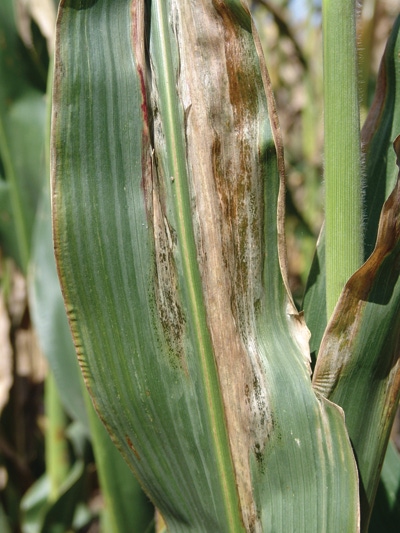August 19, 2011

As the old adage goes, “All that glitters is not gold.” Likewise, all that glitters is not Goss’ wilt this growing season. “When a disease that has occurred only sporadically in past seasons suddenly becomes a big player, worries and conjecture abound,” says Suzanne Bissonnette, University of Illinois (U of I) plant clinic coordinator.
In the past few weeks, Goss’ wilt has been reported from a number of areas east of the Mississippi River where the disease sporadically occurred in isolated fields. Initial symptoms are linear, chlorotic to necrotic lesions with a silver-colored, water-soaked appearance at edges where the disease is advancing. Symptoms known as “leaf freckles” also are prominent at edges of lesions. Leaf freckles appear as dark green to black spots about the size of a pinhead.
Symptoms continue to advance on susceptible hybrids, resulting in large areas of dead leaf tissue. When this occurs, affected areas of leaves may have a shellac-like, glittery appearance due to the bacteria oozing to the leaf surface, says U of I crop sciences professor emeritus Jerald Pataky. On hybrids with moderate levels of resistance, initial symptoms are similar to those on susceptible hybrids, but the extent of leaf area affected is considerably less.
“Keep an open mind when making observations for presence of Goss’ wilt,” says Carl Bradley, U of I Extension plant pathologist. “Numerous factors other than Goss’ wilt can contribute to large necrotic areas on corn leaves. For example, heat stress, drought stress and nutrient deficiencies are prominent causes of dead and dying leaves in lower and middle plant canopies.”
Bissonnette says it can be tricky to observe these large areas of dead tissue because they tend to be colonized by fungi called saprophytes that grow in patches on dead tissue. Growth of saprophytes may be confused with the “leaf freckles” caused by Goss’ wilt.
The distress surrounding this epidemic may be due in part to a readily available immuno-strip test that can test for Clavibacter, the genus of bacteria that causes Goss’ wilt. The immuno-strip test was developed for the tomato canker bacterium, Clavibacter michiganensis michiganensis, but it also detects the Goss’ wilt bacterium (Clavibacter michiganensis nebraskensis) and other species of Clavibacter. A positive Clavibacter immuno-strip test indicates that the Goss’ wilt bacterium or a related organism is present
“The U of I Plant Clinic laboratory diagnosis also depends on the presence of bacterial streaming in the affected tissue and a critical examination of the symptoms,” Bissonnette said. All three of these factors need to be positive for the diagnosis of Goss’ wilt. Sterile sample preparation procedures also are followed when testing to prevent contamination.”
How should you interpret a positive result?
“A positive laboratory result doesn’t mean the whole field has Goss’ wilt, it means the sample does,” Bissonnette says. “Also, a positive result doesn’t always mean that the infection of that plant is severe – it means the bacterium is present.”
Additionally, as with all diagnoses, consider other factors that may be contributing to the issue, Bradley says. Other leaf blights, bacterial and fungal, may be present. Consider environmental conditions such as drought, or heat. Consider nutrient deficiencies or excesses. One or more of these factors can contribute to the widespread leaf necrosis being noted in the field this season. Any or all of these factors will each contribute to yield loss if present.
A proper diagnosis and methodical analysis of the whole situation in a field will help determine if management tactics such as rotation, tillage and selection of hybrids with adequate levels of resistance may be necessary to prevent Goss’ wilt from occurring in subsequent years.
For more information from the U of I Plant Clinic. U of I also has photos comparing Goss’ Wilt to other diseases.
You May Also Like




